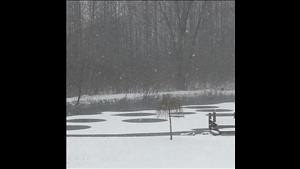 This just in, Last Friday, during an early spring snowstorm, Eden resident Peggy Gervase was looking at the pond near her home when she noticed an unusual pattern in the snow covering the water's surface: large circles that resembled giant polka dots.
This just in, Last Friday, during an early spring snowstorm, Eden resident Peggy Gervase was looking at the pond near her home when she noticed an unusual pattern in the snow covering the water's surface: large circles that resembled giant polka dots.
"I've never seen this before in our pond," Gervase told local TV station WGRZ. "It's eerie in a way, but cool in a way."
After Gervase posted a photograph of the pond circles to the station's Facebook page,
respondents offered a number of explanations for the strange circles, including
elephant footprints, fish flatulence and aliens.
Though aliens sometimes get the blame for crop
circles and other
unusual phenomenon, with no real evidence, Gervase isn't buying it, "I'm not that far gone
yet," she told WGRZ.
There are more rational explanations: Natural
springs often feed ponds with slightly warmer water than the water freezing at
the pond's surface during cold weather. As the warmer spring water rises, it
would melt the snow and ice on the pond's surface.
Additionally, decaying vegetation on the bottom of
the pond could release gases that slowly rise to the surface, creating the
polka-dot effect.
Intriguing circular formations are known to occur
throughout the natural world during seasonal freeze and thaw cycles.
In areas of permafrost (like the northern Canadian
tundra), the expansion of ice beneath the soil surface — a process called frost
heaving — creates
raised landforms called lithalsas. Lithalsas often form circular or ring-shaped patterns on the
surface.
Frost heaving also creates a related landform
called a pingo. Over many years, pingos can grow into small, circular hills: The tallest
known pingo is the Kadleroshilik Pingo in Alaska, which reaches 178 feet (54 meters) in height.
Naturally formed, perfectly round, frozen pond circles, this seemed a little suspicious. Maybe another cover up, another example of government generated, press fueled, misinformation. But, it turns out to be one more example of "life imitating art." A quick internet search for "bizarre, yet completely normal, and adequately explained natural phenomenon" provided several more examples.
 For example, this oddly shaped storm damage caused by hail, wind, and driving rain in a wheat field right outside Garden City, Kansas.
For example, this oddly shaped storm damage caused by hail, wind, and driving rain in a wheat field right outside Garden City, Kansas.  Or, the unusual erosion pattern that has formed this breathtaking vista in the Black Hills of South Dakota.
Or, the unusual erosion pattern that has formed this breathtaking vista in the Black Hills of South Dakota. There is no cause for alarm, these things are easily explained. Just relax and enjoy life.


No comments:
Post a Comment